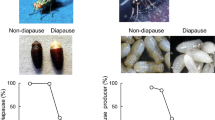Summary
The Photoperiodic Determination Model proposed earlier (I, II) is further elaborated, and its applicability to nondiel photoperiods tested. Model-generated predictions of diapause incidences were in good agreement with observed incidences among larvae of the European corn borer,Ostrinia nubilalis, reared under photoperiods from 15 to 50 hrs duration with scotophases of from 9 to 18 hrs.
Similar content being viewed by others
References
Adkisson, P. L.: Internal clocks and insect diapause. Science154, 234–241 (1966)
Beck, S. D.: Photoperiodic induction of diapause in an insect. Biol. Bull.122, 1–12 (1962)
Beck, S. D.: Physiology and ecology of photoperiodism. Bull. entomol. Soc. Amer.9, 8–16 (1963)
Beck, S. D.: Time-measurement in insect photoperiodism. Amer. Natur.98, 329–346 (1964)
Beck, S. D.: Environmental photoperiod and the programming of insect development. In: Evolution and environment (E. T. Drake, ed.), p. 279–296. New Haven and London: Yale University Press 1968a
Beck, S. D.: Insect photoperiodism, 288 pp. New York and London: Academic Press 1968b
Beck, S. D.: Photoperiodic determination of insect development and diapause. I. Oscillators, hourglasses, and a determination model. J. comp. Physiol.90, 275–295 (1974a)
Beck, S. D.: Photoperiodic determination of insect development and diapause. II. The determination gate in a theoretical model. J. comp. Physiol.90, 297–310 (1974b)
Beck, S. D., Alexander, N.: Chemically and photoperiodically induced diapause development in the European corn borer,Ostrinia nubilalis. Biol. Bull.126, 175–184 (1964)
Beck, S. D., Hanec, W.: Diapause in the European corn borer,Pyrausta nubilalis. J. Insect Physiol.4, 304–318 (1960)
Brady, J.: The physiology of insect circadian rhythms. Adv. Insect Physiol.10, 1–115 (1974)
Claret, J.: La levée photopériodique de la diapause nymphale dePieris brassicae (L). C. R. Acad. Sci. (Paris)277, 733–735 (1973)
Danilevskii, A. S.: Photoperiodism and seasonal development of insects. 283 pp. London: Oliver and Boyd 1965
Danilevskii, A. S., Goryshin, N. I., Tyshchenko, V. P.: Biological rhythms in terrestrial arthropods. Ann. Rev. Entomol.15, 201–244 (1970)
Goryshin, N. I., Tyshchenko, V. P.: On the accumulation of the photoperiodic information during the diapause induction inBaranthra brassicae L. [in Russian]. Entomol. Rev.52, 249–255 (1973)
Hamner, W.: Hour-glass dusk and rhythmic dawn timers control diapause in the codling moth. J. Insect Physiol.15, 1499–1504 (1969)
Lees, A. D.: The role of photoperiod and temperature in the determination of parthenogenetic and sexual forms in the aphidMegoura viciae Buckton. II. The operation of the “interval timer” in young clones. J. Insect Physiol.4, 154–175 (1960)
Lees, A. D.: Photoperiodism in insects. Photophysiology4, 47–137 (1968)
Pittendrigh, C. S.: The circadian oscillation inDrosophila pupae: A model for the photoperiodic clock. Z. Pflanzenphysiol.54, 275–307 (1966)
Saunders, D. S.: Circadian clock in insect photoperiodism. Science168, 601–603 (1970)
Saunders, D. S.: The temperature-compensated photoperiodic clock ‘programming’ development and pupal diapause in the flesh-fly,Sarcophaga argyrostoma. J. Insect Physiol.17, 801–812 (1971)
Saunders, D. S.: Circadian control of larval growth rate inSarcophaga argyrostoma. Proc. nat. Acad. Sci. (Wash.)69, 2738–2740 (1972)
Saunders, D. S.: The photoperiodic clock in the fleshfly,Sarcophaga argyrostoma. J. Insect Physiol.19, 1941–1954 (1973)
Saunders, D. S.: Evidence for ‘dawn’ and ‘dusk’ oscillators in theNasonia photoperiodic clock. J. Insect Physiol.20, 77–88 (1974)
Truman, J. W.: Hour-glass behavior of the circadian clock controlling eclosion of the silkwormAntheraea pernyi. Proc. nat. Acad. Sci. (Wash.)68, 595–599 (1971)
Author information
Authors and Affiliations
Additional information
Research supported by the College of Agricultural and Life Sciences, University of Wisconsin, and by a research grant (GM-07557) from the National Institutes of Health.
Rights and permissions
About this article
Cite this article
Beck, S.D. Photoperiodic determination of insect development and diapause. J. Comp. Physiol. 103, 227–245 (1975). https://doi.org/10.1007/BF00617123
Received:
Issue Date:
DOI: https://doi.org/10.1007/BF00617123




